 W
WAaqbe, Akbeh, Aqbe, Akbe, Aaqabet, el-Aaqbe, Akraba, Aaqabet Rashaya or Akabe (العقبه) is a village and municipality situated 3 kilometres (1.9 mi) west of Rashaya in the Rashaya District of the Beqaa Governorate in Lebanon.
 W
WAfqa is a village and municipality located in the Byblos District of the Mount Lebanon Governorate, 71 kilometres (44 mi) northeast of Beirut in Lebanon. It has an average elevation of 1,200 meters above sea level and a total land area of 934 hectares. Its inhabitants are predominantly Shia Muslims.
 W
WAin Aata, Ain Ata, 'Ain 'Ata or Ayn Aata is a village and municipality situated southwest of Rashaya, 99 kilometres (62 mi) south-east of Beirut, in the Rashaya District of the Beqaa Governorate in Lebanon.
 W
WAmioun is the capital of the predominantly Greek Orthodox Koura District in the north of Lebanon.
 W
WArqa (Arabic: عرقا; canaanite: Irqata also in phonecian is a Sunni village near Miniara in Akkar Governorate, Lebanon, 22 km northeast of Tripoli, near the coast.
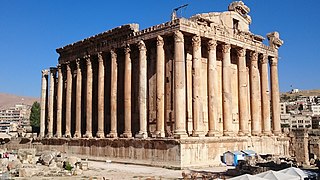 W
WBaalbek is a city located east of the Litani River in Lebanon's Beqaa Valley, about 67 km (42 mi) northeast of Beirut. It is the capital of Baalbek-Hermel Governorate. In Greek and Roman times Baalbek was also known as Heliopolis. In 1998 Baalbek had a population of 82,608, mostly Shia Muslims, followed by Sunni Muslims and Christians.
 W
WBakka, Bekka or Beka is a village and municipality situated 85 kilometres (53 mi) east of Beirut in the Rashaya District of the Beqaa Governorate in Lebanon. The population of the village is Sunni.
 W
WBatroumine is a small Greek Orthodox village located in north Lebanon. The village is known too for Olives, Oil, Soap, Grapes, Wine, Arak, Figs and Blueberries production.
 W
WBeirut, the capital of Lebanon, is home to two hippodromes, a historic one from the Roman era and a modern one that was built in the late 19th century.
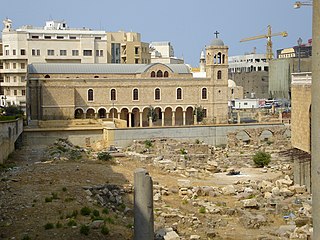 W
WBerytus, briefly known as Laodicea in Phoenicia or Laodicea in Canaan from the 2nd century to 64 BCE, was the ancient city of Beirut from the Hellenistic period through the Roman and Early Byzantine period/late antiquity. The city had been rebuilt by the Seleucids in the 2nd century BCE over the ruins of an older settlement centred on a Phoenician port dating back to Iron Age III and Persian periods. Berytus became a Roman colonia that would be the center of Roman presence in the eastern Mediterranean shores south of Anatolia. The veterans of two Roman legions under Augustus were established in the city, that afterward quickly became Romanized and was the only fully Latin-speaking city in the Syria-Phoenicia region until the fourth century. Although Berytus was an important city, Tyre was made the capital of the Roman province of Phoenicia. "Of the great law schools of Rome, Constantinople, and Berytus", the law school of Berytus stood "pre-eminent". The Code of Justinian was mostly created in this school.
 W
WBodai is a Lebanese town in Baalbek District, Baalbek-Hermel Governorate, situated west of the Litani River in the foothills of Mount Lebanon. Bodai is located 15 km northwest of the ancient city of Baalbek and 26 km from the Lebanese–Syrian border and is 90 kilometers (55.926 mi) away from the capital of Beirut. Bodai, which sits in the foothills of the Mount Lebanon range, has views across the Beqaa Valley toward the city of Baalbek, and the Anti-Lebanon range that divides Lebanon from Syria.
 W
WByblos is the largest city in the Mount Lebanon Governorate of Lebanon. It is believed to have been first occupied between 8800 and 7000 BC and continuously inhabited since 5000 BC, making it one of the oldest continuously inhabited cities in the world. It is a UNESCO World Heritage Site.
 W
WCardo Decumanus Crossing was in the heart of Roman Berytus.
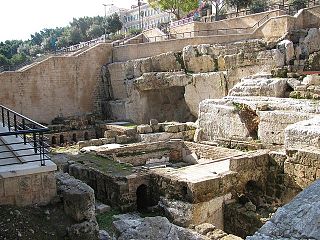 W
WColonnaded Street is located in downtown Beirut, Lebanon. it was an important street of Roman Berytus.
 W
WDakoue is a village located 3 kilometres (1.9 mi) southwest of Mejdel Anjar, Lebanon. It is predominantly inhabited by shepherds and farmers.
 W
WEl Mansourieh is a village in the Matn District of the Mount Lebanon Governorate, Lebanon. It is historically important because of the archaeological remains of a Roman aqueduct.
 W
WHebbariye, Hebbariyeh, Hebbariya or Hebariya is a village and municipality situated in the Hasbaya District of the Nabatieh Governorate in Lebanon. It is located on the southwestern slopes of Mount Hermon near the Syrian border, northeast of Rachaya Al Foukhar and is positioned amongst orchards of apricot trees.
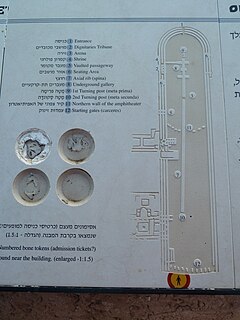 W
WThe hippodrome of Berytus was a circus in the Roman colony of Berytus. It is one of two hippodromes in Beirut.
 W
WKarak is a village in the municipality of Zahle in the Zahle District of the Beqaa Governorate in eastern Lebanon. It is located on the Baalbek road close to Zahle. Karak contains a sarcophagus claimed by the locals to be the tomb of Noah. The inhabitants of Karak are Melkites, Maronites and Shia Muslims.
 W
WKhirbet El-Knese, El-Knese or El Knese are two Roman temples south of Yanta, north of Rashaya in the Rashaya District of the Beqaa Governorate in Lebanon.
 W
WLabweh, Laboué, Labwe or Al-Labweh is a village at an elevation of 950 metres (3,120 ft) on a foothill of the Anti-Lebanon mountains in Baalbek District, Baalbek-Hermel Governorate, Lebanon. It is famous because of the archaeological remains, like a Roman temple converted in a Byzantine fortress.
 W
WThe law school of Berytus was a center for the study of Roman law in classical antiquity located in Berytus. It flourished under the patronage of the Roman emperors and functioned as the Roman Empire's preeminent center of jurisprudence until its destruction in AD 551.
 W
WLibbaya (لبايا) is a village in the Beka'a Valley of Lebanon, situated in the Western Beqaa District of the Beqaa Governorate. It lies southeast of Sohmor.
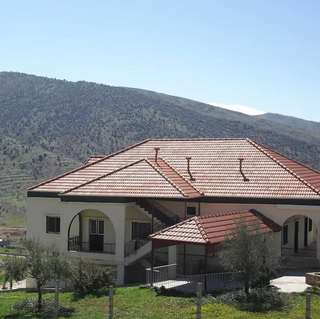 W
WMdoukha is a village and municipality situated 72 kilometres (45 mi) east of Beirut in the Rashaya District, Beqaa Governorate, Lebanon. The village's population is Sunni. A significant majority of the population are also Lebanese Canadians, of which 60% live in London, Ontario.
 W
WThe Monastery of Saint Maron, also called the Cave of the monks, is an ancient cavern - used as a Maronite monastery - carved out of solid rock in the side of a cliff, located around 200 metres (660 ft) from Ain ez Zarqa, the source of the Orontes river, and south of Hermel in Baalbek-Hermel Governorate, northern Lebanon. It is named after Saint Maron whose life and works at the location is associated with the establishment of the Maronite Church.
 W
WNahle, is a village situated 6 kilometres (3.7 mi) northeast of Baalbek in Baalbek District, Baalbek-Hermel Governorate, Lebanon.
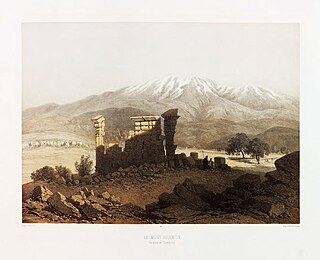 W
WNebi Safa, Nabi Safa, Neby Sufa, An Nabi Safa, An Nabi Safa' or En Nabi Safa also known as Mazraet Selsata or Thelthatha is a village in the Kfar Mishki municipality situated 13 kilometres (8.1 mi) west of Rashaya in the Rashaya District of the Beqaa Governorate in Lebanon.
 W
WNiha is a village in the Bekaa Valley about 8 km (5.0 mi) north of Zahlé. It is famous for its Roman archeological ruins, and in particular two lower Roman temples that date back to the 1st century AD.
 W
WQal'at Bustra or Qalat Bustra is an archaeological site in Lebanon, close to the border of the Sheba Farms region of the Israeli-occupied Golan Heights, about 5 km ENE of Ghajar. It is situated on a peak of height 786m with a panoramic westward view. Qal'at Bustr is believed to be an ancient Roman sanctuary and was excavated by Israeli archaeologists. Remains found at the site include a farmhouse and temple dating from the Hellenistic and Roman period.
 W
WQalaat Tannour is a Shepherd Neolithic archaeological site located halfway between Britel and Haour Taala, 12 kilometres (7.5 mi) southwest of Baalbek in the Baalbek District of the Beqaa Governorate in Lebanon.
 W
WQasr Chbib is a complex of two Roman temples situated a few hundred meters from the summit of Mount Hermon. Officially in the Quneitra District of Syria, Web mapping shows the ruins to be in the Hasbaya District of the Nabatieh Governorate in Lebanon.
 W
WQasr el Banat is an ancient temple situated 1.5 kilometres (0.93 mi) east of Chlifa in the Baalbek District of the Beqaa Governorate in the city of Qsarnaba (Lebanon).
 W
WThe Roman temple of Bziza is a well-preserved first century AD building dedicated to Azizos, a personification of the morning star in the Canaanite mythology. This Roman temple lends the modern Lebanese town of Bziza its current name as Bziza is a corruption of Beth Azizo meaning the house or temple of Azizos. Azizos is identified as Ares by Julian the Apostate.
 W
WSaraain El Faouqa is a village located 6 kilometres (3.7 mi) northeast of Rayak in Baalbek District, Baalbek-Hermel Governorate, Lebanon. Most of its inhabitants Shia Muslims and a minority are Maronites.
 W
WShhiim alternatively written as Shheem or Chhim/Chhîm is a town in Lebanon which is located 42 kilometres south-east of Beirut. Shhiim is located on 4 mountains in the Chouf region in lebanon. Chhim has a population of about 49,000. It is considered a city by some.
 W
WThe Stone of the Pregnant Woman or Stone of the South is a Roman monolith in Baalbek, Lebanon. Together with another ancient stone block nearby, it is among the largest monoliths ever quarried. The two building blocks were presumably intended for the nearby Roman temple complex, possibly as an addition to the so-called trilithon, and are characterised by a monolithic gigantism that was unparallelled in antiquity.
 W
WTemnin el-Foka is a small village in the Baalbek District in Lebanon.
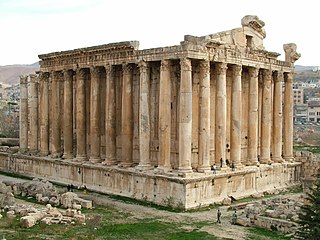 W
WThe Temple of Bacchus is part of the Baalbek temple complex located in the broad Al-biqā, Lebanon. The temple complex is considered an outstanding archaeological and artistic site of Imperial Roman Architecture and was inscribed as an UNESCO World Heritage site in 1984. This monument to Bacchus is one of the best preserved and grandest Roman temple ruins; its age is unknown, but its fine ornamentation can be dated to the second century CE.
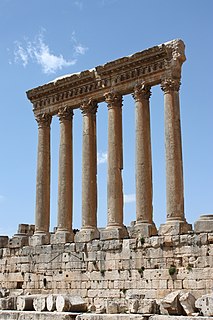 W
WThe Temple of Jupiter is a colossal Roman temple, the largest of the Roman world, situated at the Baalbek complex in Heliopolis Syriaca. The temple served as an oracle and was dedicated to Jupiter Heliopolitanus.
 W
WThe Temples of Mount Hermon are around thirty Roman shrines and Roman temples that are dispersed around the slopes of Mount Hermon in Lebanon, Israel and Syria. A few temples are built on former buildings of the Phoenician & Hellenistic era, but nearly all are considered to be of Roman construction and were largely abandoned during the persecution of pagans in the late Roman Empire.
 W
WThe Temples of the Beqaa Valley are a number of shrines and Roman temples that are dispersed around the Beqaa Valley in Lebanon. The most important and famous are those in Roman Heliopolis. A few temples are built on former buildings of the Phoenician & Hellenistic era, but all are considered to be of Roman construction and were started to be abandoned after the fourth century with the fall of the Roman Paganism.
 W
WThe Tyre Hippodrome is a UNESCO World Heritage site of the city of Tyre in south Lebanon dating back to the Second century CE The Expositio, a description of the world written in the second half of the fourth century by an unknown writer about circuses in the Roman empire, names the Tyre Hippodrome as one of the five best racecourses in the Levant.
 W
WThe Al-Bass Tyre necropolis is a Lebanese UNESCO World Heritage site in the city of Tyre situated next to the el-Buss refugee camp. The necropolis, constituting the principal entrance of the town in antique times, is to be found on either side of a wide Roman and Byzantine avenue dominated by a triumphal arch of the 2nd century. Other important monumental vestiges of this archaeological area are an aqueduct, which carried water to the city, and a 2nd-century hippodrome.
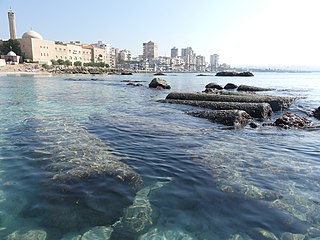 W
WTyre is one of the oldest continually inhabited cities in the world, though in medieval times for some centuries by just a tiny population. It was one of the earliest Phoenician metropolises and the legendary birthplace of Europa, her brothers Cadmus and Phoenix, as well as Carthage's founder Dido (Elissa). The city has many ancient sites, including the Tyre Hippodrome, and was added as a whole to UNESCO's list of World Heritage Sites in 1984.
 W
WYammoune is a lake, nature reserve, village and municipality situated 27 kilometres (17 mi) northwest of Baalbek in Baalbek District, Baalbek-Hermel Governorate, Lebanon. The village has a few hundred inhabitants.